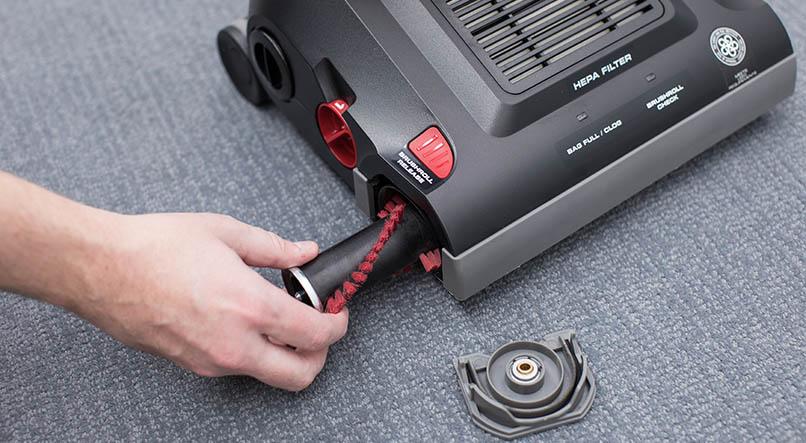
Time Invested in Equipment Maintenance Saves Time for Cleaning

Most consumers would never run their cars without changing the oil every 5,000 miles. The same care should be applied to keep professional carpet cleaning equipment in top-performing condition. Regular maintenance and routine inspection can prevent downtime and ensure equipment and cleaning crews deliver peak performance time after time.
Here are some important maintenance steps cleaning professionals should follow to keep carpet cleaning machines in top condition.
Vacuums
Since vacuums are often the most used equipment, they should be inspected regularly to identify parts or accessories that are worn or need cleaning. The following steps should be part of a routine maintenance plan.
1. Brush rolls: Ensure the brush roll of each vacuum is properly seated in its housing. Avoid vacuuming larger items that can get clogged and damage the brush roll. Inspect the brush roll daily for worn bristle strips that can reduce cleaning performance. Also remove string, hair or other obstructions that wrap around the brush roll. A brush roll will typically need replacing every two-to-three months.
2. Belts: Avoid picking up large items that can dislodge or damage the belt. Shut down the vacuum if you notice a difference in motor sound, such as roaring, or if you smell burning rubber. If either of these occurs, re-install or replace the belt.
3. Bags: Overfilling bags will reduce the vacuum's airflow and prevent the machine from removing dust and debris from carpet. Check the bag daily and replace it when it is 75 percent full. If you are working at a job site away from your supply stock, be sure to take extra bags to the job site.
4. Filters: These accessories are important for preventing dust and allergens from becoming airborne. A clogged filter restricts airflow and limits a vacuum's cleaning performance. Check filters daily to see that they are not excessively soiled. If you notice a washable filter is soiled, replace it with a clean filter and wash the soiled filter according to your manufacturer's instructions. Note that washable filters will eventually need to be replaced, especially if it is heavily soiled and/or exerting a smell that washing does not neutralize. If the filter is disposable, replace it with a new one. Also check for obstructions in the vacuum's clog ports or fan chambers.
5. Hoses: Make sure the hose on the vacuum is properly attached to the machine to ensure suction and cleaning performance. Routinely check the interior of the hose to determine whether it is heavily soiled or clogged, especially if you notice decreased vacuum performance or unusual smells.
6. Cords: Make sure all connections (where the cord connects to the unit or plugs into a wall outlet) are not damaged or frayed. Also inspect the entire length of the cord for cuts or frayed wiring that might have occurred by rubbing across furnishings or wall corners, or by having been run over by the vacuum. Have damaged cords repaired at an authorized repair shop.
Consider purchasing vacuums with quick-change pigtail cords to reduce downtime and repair costs. If the power cord is damaged, you can simply replace it with an off-the-shelf cord. It's a smart solution that will significantly reduce downtime and repair costs, thereby reducing cost of ownership. Keep a spare extension cord on hand for quick replacements if necessary.
7. Exterior: Check for damage to the exterior housing. Cracked panels or broken latches could hamper operation and the proper seating of the dirt collection bag or brush roll. Take the damaged vacuum to an authorized service center for repair, or replace the machine.
Extractors
Because they apply water to carpets, extractors require some special routine maintenance.
Water lines and tanks should be kept free of chemicals and hard water. Inspect tanks and water lines for cracks or leaks daily. Tanks and water lines should be cleaned immediately after use.
1. Nozzles and wands: Make sure the tips of the sprayer are free of debris and mineral buildup. Inspect wands before use to make sure there are no dents or cracks in the head that contacts carpet.
2. Hoses and hose connections: Ensure hose connections are not leaking and there are no tears or cracks in the suction or solution hoses. Look for and clear obstructions in the hoses. Clean the hoses and hose connections after each use.
3. Self-contained extractors: Check the brush roll periodically for wear and tear and excessive debris. Check the wheels, tanks, cord connection and switches for wear and tear.
4. Power source: Ensure you use the proper power and correct gauge cord for the machine as specified in the owner's manual. If using a heated extractor, you may need to use a separate circuit.
Train employees how to identify and respond to equipment maintenance issues or designate someone on the team to be responsible for equipment inspection and repairs. These efforts will pay for themselves by reducing costly repairs and downtime for cleaning crews. And will keep customers satisfied knowing that the team is delivering outstanding cleaning results.
Dalvin Green is product manager for Sanitaire®, "The Ultimate Time Machine."

Leave a comment